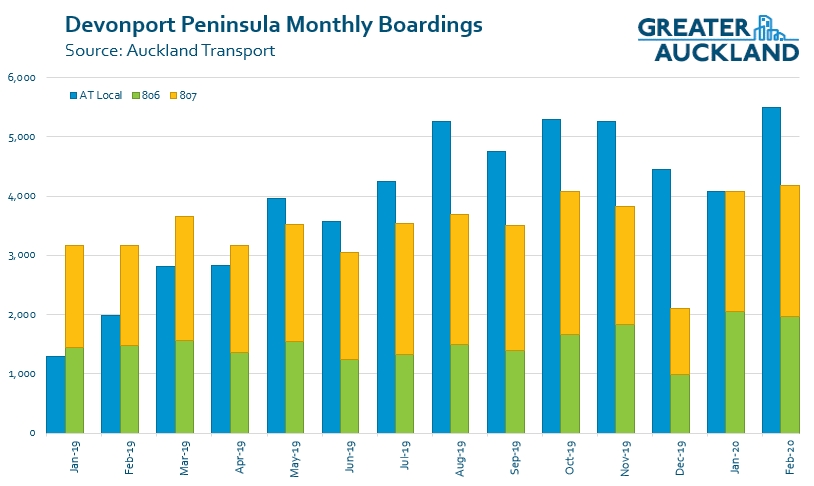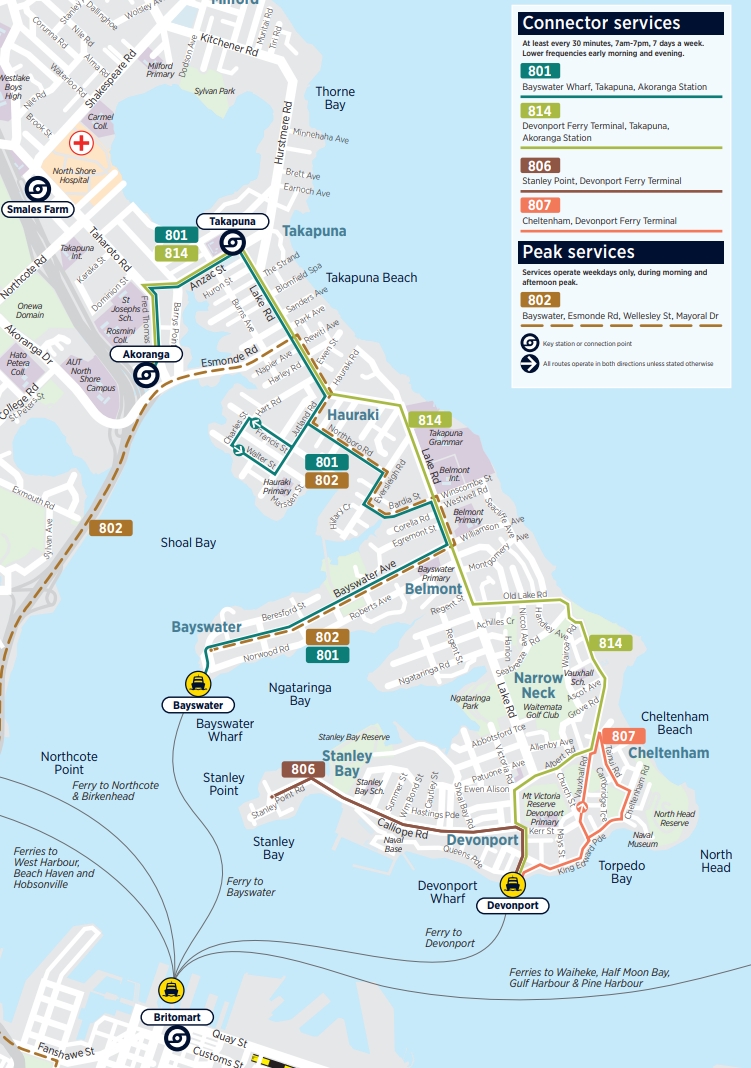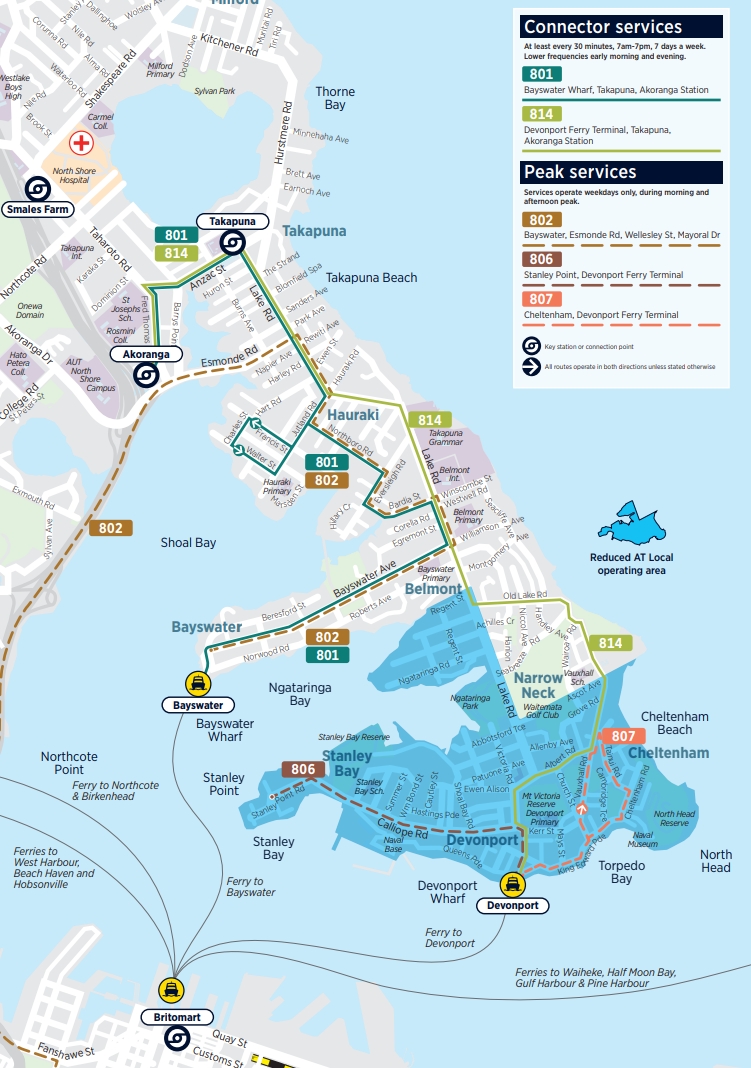Auckland Transport have been weirdly obsessed with their subsidised taxi trial in Devonport. The trial started in 2018 and was only meant to last a year but nearly two years on is still running despite not meeting targets. It has seemingly been kept alive by staff in the hope that if they continue to do the same thing, the result will change. Possibly also so they don’t have to admit to themselves they wasted more than a million of dollars of ratepayer cash trying to reinvent the wheel with an idea that had already failed in many cities overseas. The only justification AT were ever able to give was that “some customers like it”.
At least prior to COVID, the subsidised taxis had been carrying more people than the local buses but that’s not surprising given how heavily AT were promoting the service and giving out free or discounted trips. This meant it as fairly similar in cost to that of the local buses it was competing with.
The competitiveness between the two options all changed at the end of July when AT finally launched integrated fares for ferries that effectively made the local buses free to use. It would have also been interesting to see the level of use of both options if AT had made much needed changes that would have made both more successful such charging for the use of the park & ride, which remains free. This also meant that much of the usage the taxi’s did gain came not from people driving to the ferry but those walking and cycling.
COVID has knocked the usage of all public transport services and AT recently announced a raft of changes to PT services, many of which are actually positive. Where services were being cut they were focused on peak routes in places where they duplicated all-day services. However the strange overlap between the Devonport taxi’s and the local bus services were strangely absent.
That changed last week when AT announced a consultation on a couple of options for addressing this.
Auckland Transport (AT) is seeking feedback on two options for the future of the 806 bus service (Stanley Bay to Devonport Ferry Terminal), 807 bus service (Cheltenham to Devonport Ferry Service) and the AT Local service on the Devonport Peninsula.
The first option sees improvements to the current 806 and 807 bus services and the end of the AT Local service.
Option two keeps the two bus services at peak commuting times and a revised AT Local service off-peak, on the weekend and public holidays.
AT Local is a trial on-demand rideshare service using a mix of electric vans and cars operating from the Devonport, Bayswater and Stanley Bay ferry terminals.
Colin Homan, group manager Integrated Network Enablement says the bus-ferry connections in Devonport can be improved.
“If we went with the first option we could bring an additional bus onto the Stanley Bay and Cheltenham routes. This would allow us meet more of the ferries and we could run buses earlier in the morning and later in the evening.
“The second option would mean some pretty significant changes to AT Local. We’d bring fares into line with buses, customers would pay using their AT HOP card and all our usual HOP concessions would apply.”
He says fares would be part of the integrated fare structure which means the AT Local journey and the ferry trip would be treated as the same journey.
“With the local bus services and AT Local as they currently are, there’s a lot of duplication. Both options would eliminate that.”
Looking more closely at the options.
Option A
Currently a single bus runs both the 806 and 807 routes – effectively running a figure 8 loop with the ferry terminal in the middle. Each each route combined within 30 minutes. Services currently operate from 6:30am and the final loop starting at 7pm. For this option they say:
These bus services would operate:
- Monday to Thursday from 7am to 9:20pm
- Friday from 7am to 10pm
- Saturday, Sunday and public holiday from 7am to 9pm.
Bus services would operate every 20 to 30 minutes.
We would use two buses to operate the 806 and 807 service. This would allow us to provide better connections with the Devonport ferry service. We currently use the same bus to operate both services, and therefore only connect with some ferries.
I’m not sure why the buses are starting half an hour later than they do now.
Theoretically having a second bus should mean that they can operate both routes as a frequent service (as opposed to a 20 minute one suggested above) time timed to the ferries. That combined with the longer hours seems like a good improvement. The PT network map would look the same as it does now.
Option B
This feels like a last-ditch effort to save the taxis. On the surface it sounds intriguing keeping AT local just for the off-peak times but the devil is in the detail and likely represents a worse overall customer experience, particularly for anyone who is not a regular user or is visiting the area.
They say a single bus will continue to operate the 806 and 807 routes as they do now but only from 7am to 9am and again from 4pm to 6pm. Then off-peak you’ll need to need to use the AT local service. This will still require booking it via a smartphone app linked to a credit or debit card – which is odd as they also say you’ll pay for it with HOP.
We would use two 7-seater vans (plus the driver) to operate the AT Local service which would have limited ability to accommodate one-off and longer term increases in the number of people wanting to travel.
It would not be within our public transport operating budget to use more than two vans on the Devonport Peninsula. This means we would have to reduce the size of the AT Local operating area from what it is today to ensure:
- demand for the service can be met using two vans
- and Stanley Bay and Cheltenham residents and visitors would have a reliable public transport option when the 806 and 807 bus services are not operating.
Areas that would no longer be within the AT Local operating area (e.g. Bayswater, Belmont and Narrow Neck) would still be served by the 801 and 814 bus services. The smaller AT Local operating area would reduce duplication with the 801 and 814 bus services resulting in a more efficient use of ratepayers’ money.
You would be able to request AT Local for immediate travel, but if many people want to travel at the same time, your wait time may be longer, and the route the AT Local van takes may be less direct. You may have to share the AT Local van with up to six other people plus the driver, but everyone will get a seat.
The AT Local vans would only operate if someone booked a trip, but they may be empty on the way to pick someone up. Due to the limited number of seats, multiple trips would need to be made to transport a larger group of people.
The map below shows the new smaller AT Local operating area they’re proposing. This seems to create the odd situation where some areas will have off-peak service but not peak service.
When it was announced I asked Auckland Transport what each of the options were expected to cost and how many people were expected to use them. This was their answer.
Cost estimates:
- Option A: roughly $550,00-$650,000 per annum
- Option B: roughly $700,00-$800,000 per annum
Usage:
- Option A: AT have run simulations that predict around 225-275 passengers/day (assuming we operate a single bus on 806/807). If AT adds a second bus, serving a wider catchment (based on consultation feedback) and increased span of operation, the patronage is expected to be higher.
- Option B: During off-peak hours, the predicted on-demand ridership is approx. 150 a day; with buses carrying 130 a day during peaks. So total daily ridership is predicted to be 250-300 passengers / day.
Firstly it’s interesting that those costs seem to confirm that these rideshare type services are actually more expensive than just running more buses
It’s not clear if the second bus they propose to used in Option A is included in the costs above, I would assume so given it’s in the proposal. It also seems usage with that second bus would be the same, if not higher than in Option B plus provides for more capacity. All of this suggests that Option A is the better overall choice.
Finally it’s also notable that everywhere else in the region AT just made changes unilaterally but in Devonport they’re running a full consultation.





 Processing...
Processing...
Scooters. Forget the vans – just give out scooters to Devonport residents. Save heaps of money. Its a nice commute on a scoot, and downhill all the way to the ferry terminal.
+1
True, for the cost of running this, a one off investment of free scooter actually saves money in long term.
Make sure ample secured parking is provided.
My Mum lives in Devonport and she certainly wouldn’t use a scooter. She’s not frail by any means but she is of an age where she’s weary of anything that could lead to a fall. Especially as she lives alone now. There’s many others in Devonport who are in a similar position or worse. Thought must be given to them as well as the more able bodied.
“AT have run simulations that predict around 225-275 passengers/day (assuming we operate a single bus on 806/807). If AT adds a second bus, serving a wider catchment (based on consultation feedback) and increased span of operation, the patronage is expected to be higher.”
Is that AT admitting their model is rubbish when it comes to testing better frequency and span?
Dig a big moat around the peninsular and let them sort it out themselves. Sick of funding, ideas, proposals going to the likes of Takapuna and Devonport only for the locals to shout them down and spend more money reworking them. There are areas from lesser wealth crying out for improvements.
Scooters would be a great idea…but the local board just turned down Lake Road improvements.
Joe, it’s “peninsula”- there’s no ‘r’ on the end.
Actually pen-insular sounds about right
Joe
As a resident of Takapuna I am delighted that the “Lake Road” improvements didn’t happen. One of the unspoken certainties of the proposal was that it would have delivered more car journeys. It would achieve this by the downgrading of the Esmonde Road bus lane to a T2 — more car lanes, more traffic.
Every bus journey from Milford, Takapuna on the 82 would have been compromised. With Takapuna in the midst of strong intensification the proposal was madness, particularly when AT has such poor ability to control who drives in T2 lanes.
Auckland will only resolve transport congestion issues by decreasing the number of vehicle movements. The Lake Road proposal didn’t fit that bill delivering more cars, more quickly to an already clogged motorway.
This is a “new” way of solving the last mile problem which seems to have failed. Can we just make other last mile solutions better? Is there enough secure bike parking at the terminal? Perhaps feeder bike lanes or bike lanes in general in the area? I know they shot down an upgrade recently which is insane but still. The bike is quicker than any feeder bus and way cheaper for the council than busses or their taxi.
So its not much more expensive for ride share than bus? There are obviously a lot of advantages to ride share, especially for less abled people. What are the advantages of buses? Personally I think the concept of ride share combined with RTNs is the future, why have big empty buses infrequently meandering around local streets trying to provide catchment?
Having a reliable and regular timetabled service that you don’t need to book and worry if it has capacity is an advantage.
Also having that extra capacity in case it is needed doesn’t cost more (or at least it wouldn’t once both are electric) as most of the operational cost will be for the drivers.
Matt
you are absolutely right about a regular and timetabled service and the 814 while regular has very poor frequency, 30 minute intervals. Why are Devonport and those situated along this route connected so poorly to the metropolitan centre (Takapuna)?
Surely AT has to shift away from a seeming belief that PT is all about the commute, and that there should only be 30 minute frequency because that’s how often the ferries run?
There’s lots of modeshift to happen still, Jimbo. The bus scales, with costs per ride coming down. Rideshare doesn’t.
+-300 (passengers) x $2500 (cheap e-bike cost) = $750K is a much better long term solution. Also need one AT Local vehicle for those with mobility impairments.
There are mobility impaired people all across Auckland though right?
There’s also people who might not have the confidence to handle a scooter. My mum lives in Devo, isn’t disabled, but wouldn’t have the confidence to get on a scooter. Also, I assume you’d technically be DUI if you’d had a few drinks at the pub before scooting home.
Funny how Devonport gets AT local to shuttle locals to the ferry, not Swanson to the train station, Waitakere village to Swanson train station to replace the bus that no one uses, or any number of other areas that have one form of RTN but crusty connections to it.
I think your final point speaks volumes.
If people want or need ride share they can download the Uber app and pay for it themselves. There is no need for AT to be involved in that at all.
Replace the diesel buses with electric. The electric vans should be sent to Puhinui station and Manukau bus station to serve the industrial area. Also Penrose and Otahuhu station. In the weekends they could provide a service taking families to the zoo and Motat from the nearest rail station.
The app linked to a credit or debit card would be to prove somewhat the age of the app user.
Whoops my name, darn autocorrect this morning.
If you don’t like one road in and out – don’t live on a peninsula.
It’s pretty clear some of the higher positioned AT staff live there or have family in Devonport….
While AT continue to provide free unrestricted all day parking within walking distance of the ferry terminals there is no point investing in rideshare. Either reduce the amount of public parking (say by building cycle lanes to improve access to terminal) or charge market rates and maybe then give it a go. Why would anyone go though the hassle of booking and paying for a rideshare when you can just drive down to ferry terminal and park for free yourself. It’s crazy they thought this would work.
But what is even even more crazy is when it didn’t work, to think that they could make it work with a pile of advertising. Surely everyone in Devonport already knew of this fiasco from the copy it received in local press? This scheme reflects badly on those at AT, and local politicians, who backed it to the hilt.